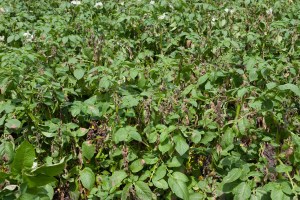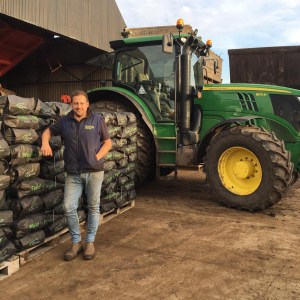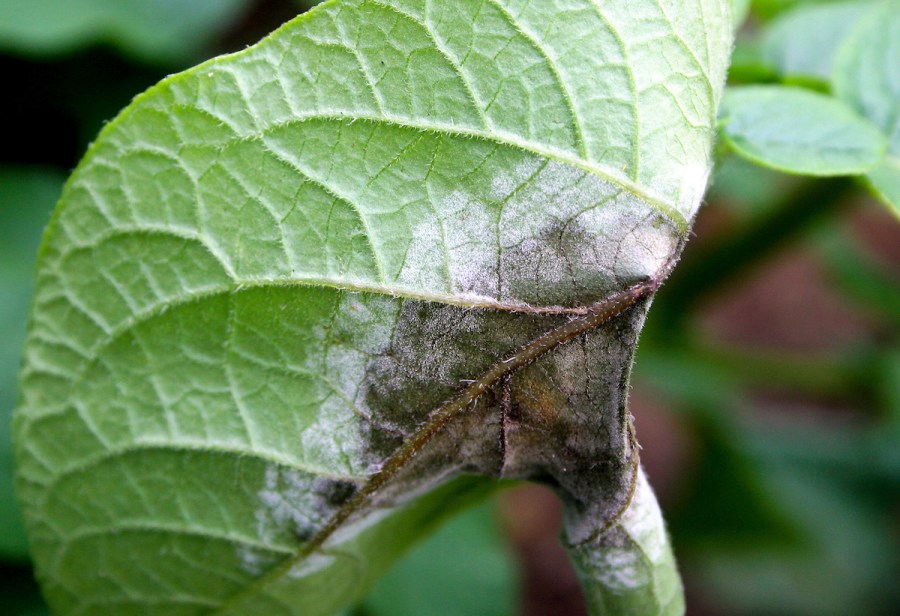With the warm and wet conditions of late playing right into the hands of blight, CPM finds out how agronomists and potato growers plan to tackle the disease head on this season.
“Crusade is a really useful insurance policy to ensure we’re not losing expensive product to the wind or through poor crop coverage.”
By Charlotte Cunningham
Blight is something potato growers are all too aware of, with the evolution and development of various strains of the disease putting greater pressure on both growers and their agronomists over recent years.
And while fungicides are available, catchy weather windows and challenging conditions puts pressure on products, meaning even the best control options can be put at risk – something Agrii agronomist Paul Dunham has found. “I cover East Anglia – a large potato growing area – and potatoes have been a struggle from the get-go this year.

Experts fear that if the warm and humid conditions continue, it could be a challenging year for potato blight.
“Due to the conditions, it has been a real struggle to get crops into the ground and, as of the latter end of May, a lot of my growers were still planting. This is proving to be very different to last year and it’s hard to describe what a ‘normal’ season is these days.”
Aside from planting challenges, Paul fears that if conditions seen lately continue it may be a particularly bad year for blight. “Blight is always an ongoing concern when growing potatoes. Early blight probably poses more of a challenge for us than late blight, especially with the potential loss of some of the key chemicals we use to protect crops.
“If things continue the way they have been, it could be a bad blight season. Hot and humid weather patterns lead to increased bouts of late blight and we could see quite a lot.”
There are also concerns that if irrigation is needed, that in itself could have a negative impact on blight levels, he adds. “Applying the water while it’s warm can create a microclimate within the crop which is essentially a breeding ground for blight.”

Paul Dunham recommends the use of drift retardant, Crusade, within the blight fungicide programme to get the most out of vital chemistry.
With so much uncertainty, being flexible with the approach to fungicides is key for both Paul and his growers. “We’ve learnt over the years how vital it is to tailor the blight programme to how severe the pressure in front of us is. If it’s not a particularly bad year, there’s no need to spend the money and go in with sprays as frequently – most people here can get away with 10-day intervals in a good year. On the other hand, in a bad year we’ll be aiming for seven-day intervals at a maximum and keeping those really tight otherwise seven days can easily turn into 10 days and leave you facing quite a difficult situation.”
To assist growers with hitting key timings and ensuring product stays on the crop for as long as possible, Paul has been recommending including a drift retardant from Interagro with blight fungicides for the past three years. “Crusade is a very good drift retardant and maximises the performance of blight fungicides significantly. Particularly when using products like Percos (ametoctradin+ dimethomorph) and Evagio (mandipropamid), my growers have commented on the difference they see when it’s included in the tank mix compared with when it’s not. These are both examples of good chemistry which can be pushed that little bit further with the right tool – in this case, Crusade.”
So how does it work? Crusade is a drift retardant designed to reduce spray drift and maximise fungicide coverage on potato crops. Where blight is concerned, it does this by removing the physical limitations on fungicides, explains Stuart Sutherland, technical manager at Interagro. “Including Crusade in the tank helps to reduce the number of fine spray droplets. These are the droplets which are smaller than 100 microns and therefore more susceptible to drift. The result of this is more product on the target which is beneficial from both a crop production and economic perspective, but is also important environmentally.”
Paul reckons this property helps aid an uplift in control. “I think that’s to do with the better canopy coverage achieved with Crusade – chemistry seems to just last a little longer on the crop.
“The beauty of it as well is that there’s no maximum growth stage cut off, so it can be used right through the season meaning it’s a tool we can lean on whenever we need it.”
Among Paul’s growers seeing the benefit of Crusade is first-generation farmer, Andrew Wagstaffe. Farming 283ha in the East, Andrew produces 65ha of potatoes a year which are bagged and sold for the chip shop trade on the open market.

Blight pressure at Andrew Wagstaffe’s farm means blight sprays are sometimes only four days apart.
Blight is the biggest annual threat to his potato crops, exacerbated by the fact that much of the ground is very black fenland, which means the blight situation can get going very quickly due to the lusciousness of the potato crops. “Sometimes this means we’re looking at three-to-four-day spray windows as a maximum,” says Andrew.
As such, Paul has found Crusade to be a vital component of the programme here. “I’m always very conscious that we use Crusade at Andy’s farm just to really try and get that chemical into the crop as well as possible as they normally have quite a thick canopy.
“The year before last was a particularly challenging blight year and we had some really good results where Crusade had been used. From memory, we had to go in with quite a robust programme as stopping blight creeping across the farm was proving to be quite difficult. Although we were using stronger products, there was quite a noticeable benefit where we’d used Crusade.”
Picking up the conversation, Andrew says that a particular feature of Crusade that he likes is its compatibility with a wide range of fungicides. “We use a lot of different types of chemistry depending on the risk level and it’s really helpful that we can still use Crusade regardless.
“Particularly in seasons where we use some of the dearer products, like Ranman Top (cyazofamid), Crusade is a really useful insurance policy to ensure we’re not losing expensive product to the wind or through poor crop coverage.”
In such a high blight population area, Andrew says that sticking to tight spray windows is something they really have to keep on top of. “When we have to go, we have to go with the blight sprays. This means conditions aren’t always perfect, but again, this is where Crusade can be really beneficial in helping keep the product where we want it. It’s also really helpful that we can use it right the way through the season.”
Andrew pairs the use of Crusade with Hypro Guardian nozzles – forward and rear facing – to aid that penetration into the canopy even further. “Anything we can do to enhance coverage really helps to improve the overall control picture. I think we’ve got to look after crops more than ever this season as it’s looking to be a high price year, which could end on an unprecedented level – prices are already £700/t for chip shop potatoes which is unheard of, so the thinking is that prices will remain firm in the coming autumn. Therefore, protecting that potential right from the start and maximising what we’ve got in the ground is vital.”
Offering his advice for the season ahead, Paul says taking a proactive, rather than reactive approach, is key. “Vigilance will be crucial this year, as will planning ahead – it’s all about getting those protectant fungicides on within good time. If you wait and see what kind of pressure you’ve got, then you’re on the back foot.
“It’s essential to get those active ingredients onto the plant and working to the best of their ability to offer protection from the get-go, before blight really strikes. Using products like Crusade alongside this approach will help get and keep products where they need to be and will be a really useful aid if disease pressure is high and weather conditions put pressure on those all-important spray windows.”
Tried and tested
The benefits of Crusade have been confirmed in four years of Syngenta trials at Eurofins and Jealotts Hill in Berkshire looking at droplet manipulation and coverage to the canopy.
Starting in 2019, blight trials conducted at the Eurofins site looked at the effect of nozzle type when using Crusade with Revus (mandipropamid) for blight control, explains Stuart Sutherland, technical manager at Interagro. “When using a Lechler IDTA 05 nozzle, blight infection with Revus was reduced, compared with the standard potato 05 nozzle. This was further reduced when Crusade was added to the mix bringing the level of blight down by 47%, compared with Revus alone.”
Researchers used UV tracer dye to identify where spray droplets were landing on the crop and concluded that Crusade helped maximise coverage across all parts of the canopy, therefore leading to this improved control.
Nozzle type and the impact on blight control was assessed again in 2020, this time using a range of nozzles with Revus alone and then with Crusade in the mix. When applied with a flat fan and a standard 05 nozzle, the inclusion of Crusade was proven to once again reduce blight infection significantly, adds Stuart.

Crusade removes fungicide limitations by reducing the number of fine spray droplets, says Stuart Sutherland..
More recently, further work looking at nozzle type and the use of Crusade has concluded the best results are achieved when paired with Syngenta’s 3D ninety nozzles. The 90% drift reduction nozzles create the optimum droplet spectrum for coverage throughout the crop canopy, including lower leaves and stems where microclimate conditions can be particularly humid and conducive to blight infection, says Stuart.
Three seasons of independent research in the Eurofins evaluation trials have shown the 3D ninety nozzle has repeatedly performed the most effectively for blight control with Revus and Amphore Plus (mandipropamid+ difenconazole) programmes. More consistent coarser droplet size of the 3D ninety has the momentum to penetrate deeper into the canopy, compared with more drift susceptible fine droplets. When that is combined with the 55 ° angle of the nozzle it is especially effective at treating larger crop canopies, such as potatoes.
In wider independent trials over the past seven years Crusade has proved its flexibility in being able to help maximise the performance of the whole blight control programme. Among those are potato blight trials at SRUC which have proven Crusade’s efficacy with a whole host of different active ingredients. In 2017 trials at the research centre, including Crusade with Ranman Top throughout the growing season resulted in a 36% reduction in blight infection – compared with using the chemistry alone.
Pushing performance

At the heart of good crop production lies careful use of chemistry to protect the plant and maintain performance, right through the season. But optimising the efficacy of plant protection products can be challenging, while increasingly restrictive regulations limit just how far you can go.
This series of articles explores the science behind the use of adjuvant and biostimulant tools to help power both chemistry and crop performance, as well as increase understanding of why they’re needed and what they do. We’re setting out to empower growers and drive crops to reach their full potential.
Crusade is a flexible anti-drift agent to maximise protection and prevent blight infection. For use with all potato blight fungicides throughout the programme, Crusade is designed to reduce spray drift and maximise coverage to all parts of the canopy, so you get the most from your spray and keep blight away.
CPM would like to thank Interagro for kindly sponsoring this article, and for providing privileged access to staff and material used to help put the article together.
This article was taken from the latest issue of CPM. For more articles like this, subscribe here.
Sign up for Crop Production Magazine’s FREE e-newsletter here.




